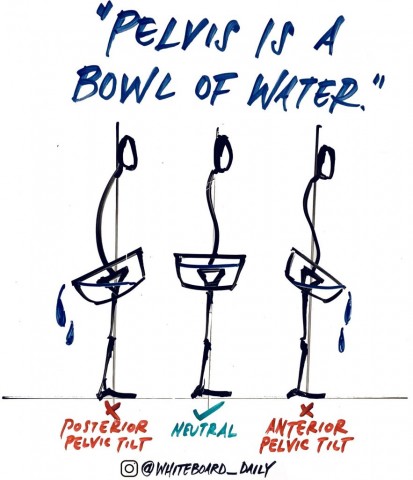There's no denying the importance of the hips in sports performance. The high degree of mobility at this joint allows us to sprint, cut, change direction, raise or lower our center of mass and jump with as much force as we can produce. But before we get started on increasing the mobility or sttrength of our hips we should make sure the hips and pelvis are optimally positioned for our posture. Sometimes the analogy of a bowl of water is used to convey the concept of the positioning of the pelvis. When we have anterior pelvic tilt we can imagine water spilling out of the front of the bowl. The opposite is true of posterior pelvic tilt. I'm not suggesting we should all have a neutral pelvis but instead we should be aware of our posture and how this can impact our movement. A 2014 study (reference below) looked at how our hip mobiliy is influenced by anterior, neutral or posterior pelvic tilt. The researchers examined the hips of 48 subjects that had surgery due to femoral acetabular impingement (FAI). The various positions of anterior pelvic tilt (10 degrees), native (no tilt) and posterior pelvic tilt (10 degrees) were analyzed in terms of hip flexion, hip internal rotation, hip adduction and the position of osseus (bony) contact (impingement). What they found was that anterior pelvic tilt was associated with lower hip flexion (6 degrees), lower internal rotation (15 degrees), lower hip adduction (8.5 degrees) and increased contact at positions of impingement. When the subjects were positioned in posterior pelvic tilt these three ranges at the hip increased and there was decreased inpingement. So for the following athletes this would be a concern for : The sprinter because speed = stride rate x stride length. Less hip flexion may result in a...
The Top 6 Travel Tips to Save Your Back
- Chris Collins
- Training
- Injury Prevention
- 1742 Hits
- 0 Comments
-
This is the follow up to the post Is Sitting Killing Your Back? A Few Quick Fixes.You provided some excellent questions and comments from that post so now as a reward I've got The Top 6 Tips to Save Your Back When Travelling. Some of these tips relate specifically to driving your vehicle and others have to do with air travel. Tip #1 - Set the Alignment Before You StartDo you think you feel better after travelling when you feel good before you start. And similarly don't you think you'd feel worse after travelling if you felt tight to begin with? Probably so.Before I get on a plane I make sure to do some foam rolling. I want to release any tension I'm carrying in my body and not put additional stress on joints. 15 minutes of foam rolling while watching tv is a small price to pay for the benefits is extends after a 5 hour flight to Hawaii.As soon as I arrive I want to make sure to target the areas that tightened up during travel and resume light activity as soon as I can.Tip #2 - Set Your Mirror Up HighOne of the most common ways we wreak havoc on our backs when sitting is by slouching. We slide forward in the chair. Our hips tuck under. Our pelvis tilts posteriorly and we round our low back. None of which is good.By setting your rear view mirror as high as possible, but still where you can see traffic, you'll be forced to sit taller and minimize the potential for slouching.And when you can't see in the mirror anymore? Don't adjust the mirror down. Instead sit up or pull over and take a break.Tip #3 - Empty Your PocketsDo you remember what George Costanza's wallet looked like on Seinfeld?It was so jam-packed...

